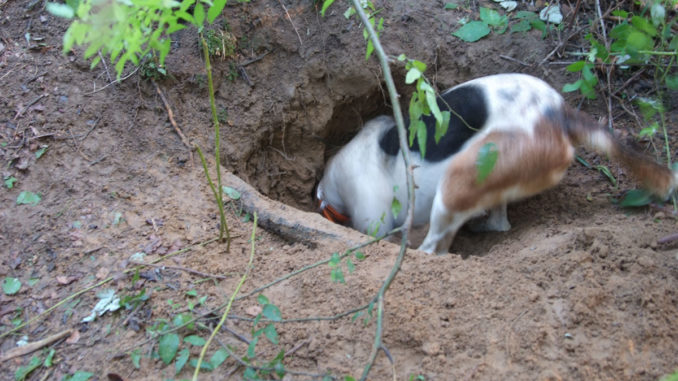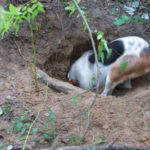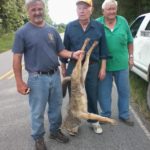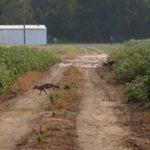
Modern equipment is great, but it’s still the fight in the dog that makes for great fox and coyote hunting in Eastern North Carolina.
Before 1983, coyotes had been recorded in only a handful of North Carolina counties. Now, they’ve become established in all 100. Over the same period of time, fox populations have decreased to the point where many hunters and trappers no longer target them. The drop has not been traced to any specific cause, but many hunters who traditionally ran foxes with dogs have switched to running coyotes.
Hunters like Slick Edmundsen of Macclesfield said when you’re running foxes or coyotes with dogs, a kill at the end of the hunt is not necessarily the goal — it’s listening to and watching the dogs work.
“The perfect hunt involves running a fox for 30 to 45 minutes and seeing them cross a path or ditch a few times,” he said. “Then, they’ll go into a hole or up a tree.”
At that point, “You can call off the dogs and let Mr. Fox live to breed another litter and be hunted another day.”
Edmundsen uses dogs to hunt foxes, coyotes, bobcats and bear — but not the same dogs in every instance.
“You need specialized dogs to hunt coyotes and foxes,” he said. “Deer dogs won’t stay on a coyote track but will break off and run a deer.”
Edmundsen uses Walker Hounds, an old line called “Hudgepeth” that he brought to North Carolina from Alabama years ago. His packs are the result of 30 years of breeding, as well as an investment of a lot of time and money. He calls them “cold trail dogs” because they can follow a day-old trail. Any dog that runs deer more than a couple of times will be culled from the pack and given to a deer hunter.
With all the money and time invested, keeping dogs safe and bringing them home from the hunt is very important. GPS tracking systems are now the norm, available from major catalog companies and specialty dog-training supply centers, with the Garmin Astro 320 among the most popular. With the collars and central receiving units, Edmundsen can keep track of exactly where all of his dogs are and where they’re headed.
Not only does this provide a means of keeping up with where the pack is headed so you can head off the coyote or fox, but if they are headed toward a major road, you can get in front and call them off to prevent an accidental run in with an automobile.
Beyond the dogs, the training and electronics, getting permission to hunt a sizeable area of woodlands or swamp is a key. Written permission from a landowner is the first step; hunters need to make sure they leave the tract of land as clean as they find it.
Once in hand, there are several ways to locate a fresh coyote trail one of the being to ride along paths or old pulpwood trails looking for signs, particularly coyote scat in or near the trail. Then, you release the dogs and let them search for the spot where the trail enters the woods. You’ll know when they find it as the pack will begin to bark excitedly and head off after the target. Another is path or road hunting where a hunter will release his dogs and then drive along the logging trail slowly as the dogs run alongside. Eventually they’ll find where an animal has crossed and will get on the trail. Both of these methods will typically lead to a good run and occasionally a shot at a coyote. Coyotes are so fast and have such high levels of endurance that it’s rare for these dogs to catch up to them.
In the open ranges of the West, hunters often use greyhounds to run coyotes; they are fast enough to catch them. President Teddy Roosevelt documented running coyotes with greyhounds about 70 miles southwest of Oklahoma City in the early 1900s.
In North Carolina, if you want to get a shot, you’ll need to get ahead of the pack and watch for the coyote to cross an open field, ditch, or path. While it’s possible to get ahead by listening to the dogs and estimating where they are headed, an easier way is to use technology. With the GPS collars and tracking systems, you can sit in the truck and watch blips on a small screen as the dogs trail their prey. Many times you’ll see the hounds split into two sets of blips as the coyotes head in separate directions. GPS map overlays allow you to see paths or logging trails you can use to get in front of the coyote. The action is fast as hunters scramble to head off the pack, either on foot or in their trucks.
Edmundsen said running coyotes with dogs is easier in the fall than on into the spring, when they’re wary from being run by deer and fox dogs all winter. Also, young-of-the-year coyotes are not nearly as wary in the fall.
“It takes some heat to run them down in the fall, but it’s near impossible in the spring,” said Edmundsen, who believes dogs have a harder time trailing coyotes or foxes when an east wind is blowing.
In the fall and early winter, Edmndsen likes to hunt around bean fields, where he’s more likely to encounter a fox than a coyotes. He usually heads to the back of large field before turning his dogs loose, starting them away from any nearby highways to reduce the chance of a dog-vehicle encounter.
A hunting party needs several vehicles — trucks or ATVs — so foxes or coyotes and the following hounds can be diverted from a road if they head that way, by yelling or making other loud noises. Edmundsen also recommends that every hunting party have a “catch man” — a younger hunter who can better keep up with the dogs than the older hunters. His job is to get to the dogs and pull them off the hunt, which may mean stopping them from digging into a hole where a fox of coyotes has denned. Finding someone who fits the bill is getting harder and harder to do, according to Edmundsen, with many young people today more focused on activities besides maintaining a pack of dogs and running foxes or coyotes. But it’s not too late to get started. Maybe in 30 years, you’ll have a quality pack of Walker hounds just itching to get in behind a fox or some coyotes.
DESTINATION INFORMATION
WHERE TO GO — Hunters use packs of hounds to hunt coyotes and foxes almost anywhere in North Carolina where populations of the animals exist and permission to hunt big chunks of land can be obtained. Prime areas are the southern part of the Dismal Swamp in northeast North Carolina and in the east-central section of the state around Pinetops and Washington.
WHEN TO GO — There is no closed season and no bag limit in counties east of I-77, but there are so many local laws, it’s worth visiting the “Fox Season Hunting and Trapping Laws” publication on www.ncwildlife.org. There is no closed season or restrictions on coyotes except in Hyde, Beaufort, Washington, Dare and Tyrrell counties, where permits are required to hunt coyotes during daylight hours. Hunting at night is prohibited. A North Carolina hunting license is required to hunt coyotes. Many hunters will wait until deer season ends to run coyotes or foxes to avoid conflicts with deer hunters.
GUIDES/INFO — Joey Godley, Huckleberry Ridge Hunting Preserve, Tarboro, 866-614-7281, specializes in wing-shooting and deer hunting but will coordinate a fox or coyote hunt for interested parties.






Be the first to comment